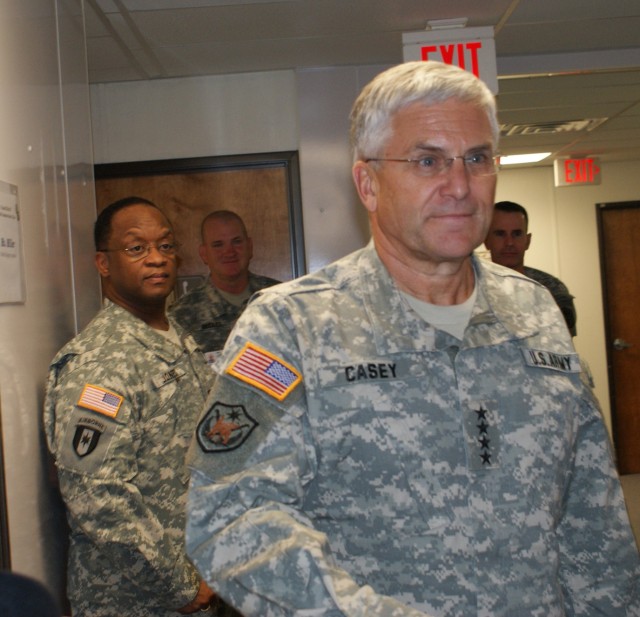
Hood, Texas Medical Evaluation Board Clinic Nov. 17, escorted by Carl R.
Darnall Army Medical Center commander Col. Casper P. Jones, III, Command
Sgt. Maj. Keith Seidler, an... VIEW ORIGINAL
FORT HOOD, Texas - The Medical Evaluation Board process has always been complex and cumbersome for the Soldier, units, and military treatment facilities, so when the number of cases surged some months ago, Carl R. Darnall Army Medical Center officials made a calculated decision to pour money and resources into restructuring and modernizing the process at Fort Hood.
"To do the right thing for our Soldiers and make our work more efficient, we consolidated the administrative functions and medical sections into one center. We also devised a method to shorten the processing time," said Maj. Dexter L. Lovett, chief of CRDAMC's Patient Administrative Division.
CRDAMC re-outfitted a building to consolidate the 56 personnel previously scattered among various departments and buildings under one roof.
Lovett said, "The consolidation of physicians, nursing assistants, medical NCOs, and case review physicians on the medical side, and PEBLOs (Physical Evaluation Board Liaison Officers), case coordinators, clerks, and NCOs on the administrative side that are involved in the MEB process means we can talk face-to-face with each other and address any issues that particular cases may bring."
"Previously, Soldiers had to connect with these medical and administrative personnel during various stages of the MEB process. This was a huge burden for our Soldiers and a real communication nightmare for us," Lovett said.
The medical center had several goals in consolidating these functions and personnel. One was to be more efficient in coordination and communication. Another was to lessen Soldiers' frustration level, while at the same time meet our regulatory requirements to process cases within prescribed timelines.
Lovett said that before the surge of cases, military treatment facilities were able to manage the 60-year-old MEB process if there was an even flow of cases.
"It became painfully obvious the system was not designed to handle surges. The huge influx of cases completely exposed the fact we have been applying bandages to an outdated system," said Lovett. The ugly sore festered at Fort Hood because of the number of cases resulting from numerous deployments.
"When you have the largest Soldier population, you have the largest workload," said Patricia Van Raalte, manager of the medical boards administrative branch. "Putting all the players in one place helps expedite the system; Consolidation gives us easy access to access to PEBLOs, and it helps our Soldiers if they have only one place to go," Van Raalte explained.
Another problem festered as a result of the Army Medical Action Plan. The AMAP placed MEB physicians uder the Warrior Transition Units.
"MEB physicians on the WTU books focused on WTU MEB cases. This left a void for other units' MEB cases, Lovett said.
"We had difficulty holding providers assigned outside of CRDAMC accountable for both the quality and timeliness of the narrative summary dictations for the MEB," said Col. Wilma Larsen, deputy commander for clinical services at CRDAMC. "We decided to improve this process by having all NARSUMS done by a cadre of MEB physicians.
CRDAMC now has nine full-time physicians on hand dedicated to MEBs who do physicals and narrative summaries for cases.

Social Sharing